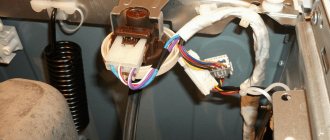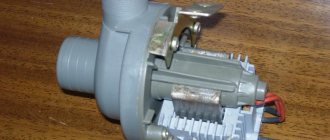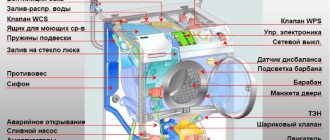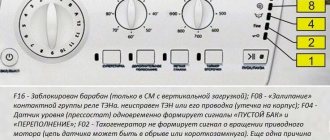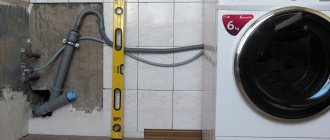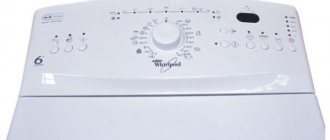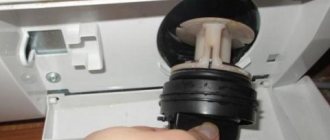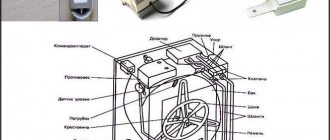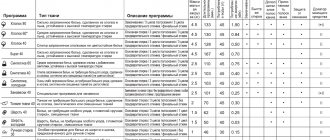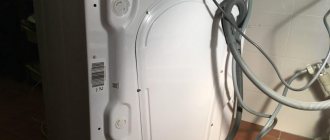The devices responsible for ensuring that everything works smoothly are control elements represented by electronic units and sensors. One of the most important parts of any washing unit is the pressure switch.
If the water level sensor is faulty, the control module of the washing machine processes the signal incorrectly or does not receive it at all from this device. In such a situation, the water level in the tank is not controlled, and therefore underfilling or overflowing occurs. All signs of a malfunction of this sensor will be described below.
What is a pressure switch
When wondering what a water level sensor is, you need to understand that any process related to the supply of water to the washing unit must be strictly regulated by a given program. According to the principle of operation, the pressure switches of washing machines Lg, Samsung, Electrolux, Candy, Ariston or any other brands do not differ, but there may be differences in design, appearance and characteristics. This device looks like a small plastic piece, usually round in shape, with electrical wiring connected to it and a tube from the washing tub tank.
The pressure switch in a washing machine is a device that controls the water level in the tank, without which the operation of any unit is simply impossible. The element is small in size, and its replacement does not require major capital investments, but the importance of this part is enormous.
Preliminary actions
As soon as you discover a malfunction, you should understand whether the reason actually lies in the part that controls the water level. It is necessary to carefully inspect the water intake system, check the sleeve and fitting of the water intake sensor, and the transition chamber section. When inspecting these parts, you should not find any tears or abrasions, as well as deposits from washing powder.
If detergent is detected on the parts, all components must be washed, after which a second attempt is made to start the washing machine. It is quite possible that you have restored the ability of the pressure switch to work.
Secondly, the correctness and strength of the electrical wiring connection to the part is checked. There is a possibility that one of the wires is worn out or bent. Having discovered such a defect, we eliminate it and perform a test run again.
Be sure to check the contact group of the pressure switch. If there is a deposit of dirt, clean it and again check the water intake sensor for serviceability.
Diagnostics is performed using a tube whose diameter matches the size of the part’s hose. We put one end of the tube on the instrument fitting, and blow into the second. If the part that controls the water intake is in good condition, light clicking sounds will be heard.
When this method of checking does not help identify problems, the pressure switch will have to be disassembled.
Operating principle of the sensor
The operating principle of the water level switch of a washing machine is based on the effect of pressure on a special membrane (diaphragm). When water is drawn into the tank of the washing unit, water fills the compression chamber and pressure corresponding to the level of the collected water is injected into the sensor housing through a special tube.
The compression chamber is usually built into the drain pipe. The pipe itself is connected to the tank and the volute from the drain pump using special clamps. There are cameras soldered directly into the tank itself. It happens that these cameras become clogged with slurry and dirt over time!
When pressure is applied to the membrane, the contacts close and open, as a result of which a signal about incoming water is sent to the control module. There are several types of pressure switch: pneumatic (mechanical) or with an oscillating circuit (electronic), in this case the mechanical principle will be described. They are also divided into single-chamber and double-chamber.
Double-chamber pressure sensors are specially developed for washing machines with small and large loads. When the load is low, one membrane is activated and water is supplied in a minimum amount. When the drum is heavily loaded, the second membrane is activated, the contacts close and the control processor gives a command to supply the maximum amount of water.
As a rule, the membrane installed inside the sensor is made of rubber or elastic polymer and is designed for repeated on and off cycles. The operating principle of the pressure switch combines the sequential influence of air pressure on the mechanical part, above which the electrical contacts are located, and a direct electrical impulse on the control processor of the washing unit.
About the device
The simplest name of the product is “washing machine water level sensor,” which also describes its main functionality. Each machine has a pressure switch, whose task is to determine the presence of water in the internal tank and its filling level. Without this sensor, the controller will not be able to determine when it is safe to start washing.
You can determine where the pressure switch is located inside the washing machine if you look closely at the round plastic device to which the wires and tubes of the tank are connected. It is small in size and easy to attach, making it easy to disconnect and connect yourself. The water level sensor includes the following components:
- Sensors The water level is measured using a built-in membrane, which receives a column of liquid. The pressure of the latter is converted into kilohertz, through which the user is informed about the degree of filling of the internal chamber of the washing machine.
- The compression chamber is located at the junction of the pressure switch and the hose through which water flows. Requires regular personal care, otherwise it quickly becomes clogged with waste and the contents of incoming liquid. If it becomes contaminated, measurements of the water level become inaccurate, and subsequently the hose stops pumping it out.
- A diaphragm or membrane that moves under pressure and clicks the core switch.
- Technical components - printed circuit board and coil. They advocate maintaining the functionality of all parts of the pressure switch, as well as converting incoming signals from the diaphragm and converting them into an accurate value.
- Ferrite core. As an alternative, a magnet is possible.
- The adjusting screw allows you to adjust the operation of the pressure switch.
- Springs that support the adjusting screw and return it to its original position.
- The housing includes all the components of the device for measuring water level, protecting them from damage during operation.
As can be seen from the description, the components of the pressure switch are quite simple and are not highly reliable, which requires careful handling of the device during its installation, dismantling and maintenance.
Signs of a malfunctioning pressure switch
As with any element of a washing unit, malfunctions can occur in the water level sensor, leading to malfunctions of the entire washing unit. This is expressed in the following signs:
- the washing process begins in the absence of water;
- water is supplied to the tank in too much or too little quantity;
- after the wash is completed, water is not removed from the tank;
- the laundry spinning program is not processed;
- There is a periodic pumping out of dirty water and supply of clean water in the rinsing mode, which is not typical for normal operation;
- malfunctions of the washing machine in all washing programs.
In addition, due to the lack of water in the tank and the heating element being turned on, smoke and a burning smell may appear. Typically, such inclusion ends with the replacement of the heating element. A faulty sensor can also lead to failure of the electric motor due to constant overload on it, since more water is often drawn into the tank than the required level.
Symptoms of a broken level sensor
How can the user guess that the reason for the malfunction of the washing machine lies precisely in the breakdown of the liquid level relay? Most automatic machines in the Indesit line are equipped with a self-diagnosis system for emerging problems. Having detected a breakdown of the pressure switch, the washing machine will immediately transmit information about the error code to the display. Using the manual for using the SMA, deciphering the code will not be difficult.
If the machine does not display a fault code, a signal about a problem with the pressure switch will be the lack of water in the drum after starting the wash. In this case, you can observe that the washing machine still turns on the heating element. Another sign of a level sensor failure is uncontrolled, continuous intake of water into the tank. And finally, poorly wrung laundry indicates that the relay has failed; the water cannot completely escape through the drain hose and the clothes remain wet.
However, these signs may also indicate a breakdown of other elements of the MCA, for example, the main control module or inlet valve. Maybe the machine is simply incorrectly connected to the utilities. To be sure that the problem is really with the pressure switch, it is important to understand how to check the level sensor in the device.
Related article: Why does your washing machine stink?
Where is the pressure switch located?
In washing machines from most manufacturers, the sensor is installed on a bracket in the upper part of the body on the side wall, however, in each specific case, you can find out where this device is located only by removing the top cover or side trim of the unit. Very rarely, on vertical types of machines, the pressure switch is located at the bottom of the unit.
A distinctive feature that makes it easy to find the sensor is a small-diameter tube connected to it, usually made of rubber or polyvinyl chloride.
Replacing the pressure switch
If checking the water level switch shows that it is faulty, then replacing it in most cases does not cause any particular difficulties. Therefore, you can change this device yourself, without resorting to the help of specialists. Repairing the device itself is not only impractical, but also useless, since the case is non-separable, any attempt to get to the internal parts will lead to a violation of its integrity. Some types of water pressure sensors must be opened, but this is a rather lengthy process and requires some competence in this area.
Replacing the pressure switch in a washing machine begins with disconnecting the vacuum tube and electrical contacts. By loosening or unscrewing the mounting bolts, remove the sensor. Reinstallation of the device is carried out in the reverse order of dismantling. Although the vast majority of sensors are similar in appearance, it must be taken into account that this element is configured for a specific model and brand of washing unit.
When carrying out all types of work, safety measures must be strictly observed. Before starting work, it is imperative to disconnect the plug of the washing unit from the power outlet.
How to check the pressure switch yourself
The water level sensor in the washing machine tank can be checked for functionality at home. To do this, it must be dismantled. Carefully inspect the pressure switch housing and vacuum tube for mechanical damage (cracks, chips, abrasions). Carefully check the tube and inlet fitting for blockages, and if there are any, clean them with a plastic stick or soft wire.
The pressure switch can be checked for functionality by blowing air into its housing using a small hose identical in diameter to the standard one. To do this, attach the hose to the inlet fitting and blow lightly into it several times. In connection with the pressure force, characteristic clicks should be heard inside the housing. The number of clicks depends on how many water levels a particular model of washing unit provides. Their absence indicates a malfunction.
The second way to check the water level sensor is to measure it with a multimeter. This method allows you to be almost one hundred percent sure that the pressure switch is faulty. By connecting the device to the pressure switch, you need to measure the resistance. If the resistance does not change when air is blown into the device body, you can safely send the faulty element for scrap.
In order to avoid undesirable consequences for the entire washing unit as a whole, it is necessary to carefully monitor its operation, and if the slightest malfunction is detected, take the necessary measures. By replacing a relatively inexpensive pressure switch in advance, you can extend the life of the entire washing machine for a long time.
The adjustment did not give a positive result: what to do?
It is quite simple to independently determine that the pressure switch has failed - signs of its failure clearly confirm the problem. But adjusting the part does not always help - there are situations when a complete replacement of the part is required.
It will not take much time to install a new water control sensor. It is necessary to partially disassemble the equipment to gain access to the pressure switch. After this, remember the electrical wiring connection diagram, disconnect it from the contacts and remove the pressure switch. Further actions are performed in the following sequence:
- a new pressure switch is attached to the system, similar to the failed one;
- a hose is connected to the water control sensor tube and secured with a clamp;
- all connections must be checked for kinks, cracks and other damage;
- The wiring is connected according to a known scheme;
- assembly is performed in reverse order, the device is started to test for functionality.
Setting the washing machine pressure switch
Along with the serviceability of all elements of the sensor, its precise adjustment is also of utmost importance. It must operate clearly at certain pressure levels, sending the necessary signals to the central control processor. The amount of water supplied to the tank depends on this, which is different at each stage of washing.
Accurate calibration of pressure switches is carried out at the manufacturer's factory using special ohmmeter devices, and under normal conditions no additional adjustment is required. Washing machine repair technicians not only do not recommend, but also categorically deny the possibility of adjusting the pressure sensor at home.
On the adjusting bolt of almost any pressure switch there is a seal, the integrity of which must not be violated. Even if you simply insert a screwdriver and turn the bolt half a turn, and then turn it the same half a turn in the opposite direction, the fine adjustment will be lost. In this case, no one can guarantee the normal operation of the washing unit.
Experiments with adjusting the water level sensor, as a rule, lead to failure of the heating element or the entire unit as a whole. If the cause of malfunctions in the washing machine is indeed the pressure switch, it is replaced entirely, and it is best if this operation is carried out by a service center technician, followed by high-quality diagnostics.
